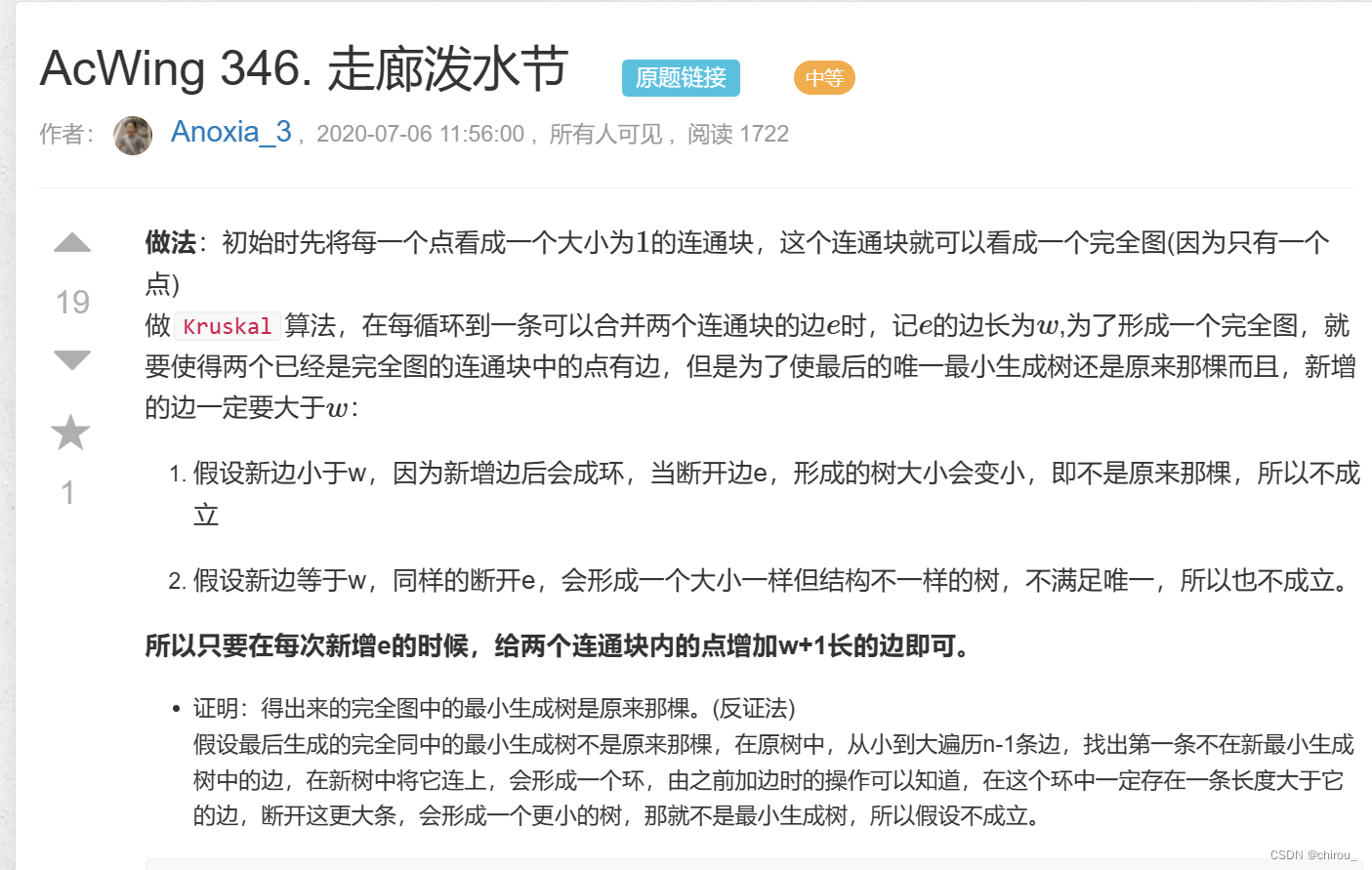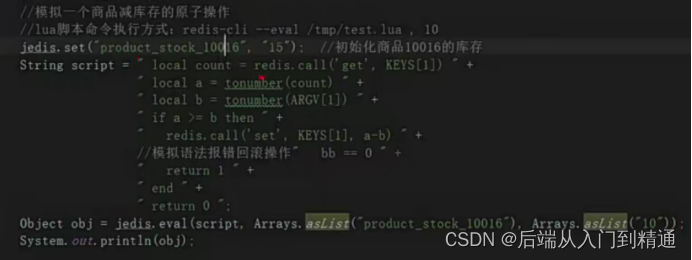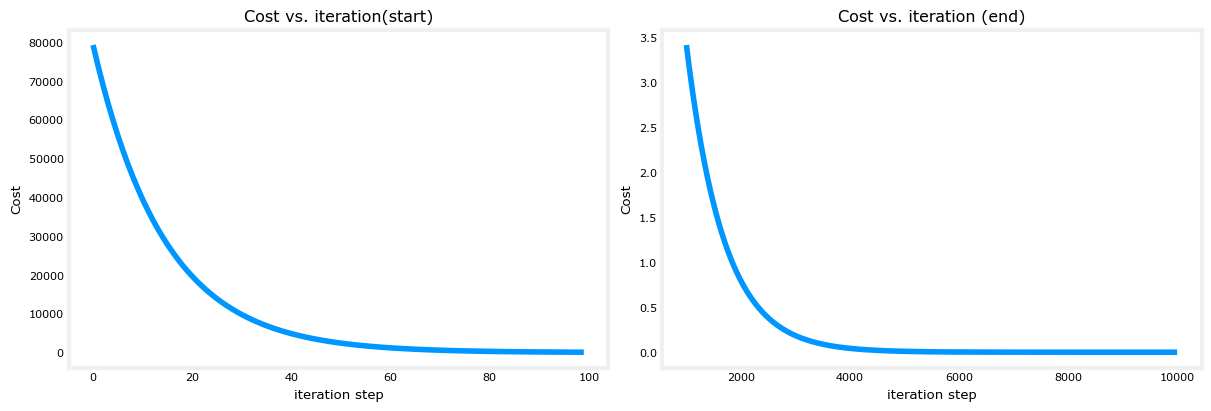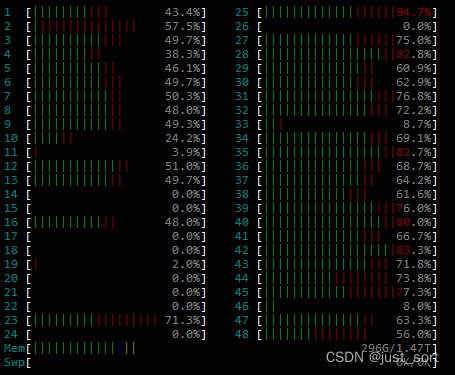最小生成树的扩展应用
- 最小生成树的扩展应用
- AcWing 1146. 新的开始
- AcWing 1145. 北极通讯网络
- AcWing 346. 走廊泼水节
- AcWing 1148. 秘密的牛奶运输
最小生成树的扩展应用
AcWing 1146. 新的开始
利用虚拟源点建图和原题的题意是等价的,因此我们使用虚拟源点建图套最小生成树的模板
//虚拟源点
#include <iostream>
#include <cstring>
const int N = 310;
using namespace std;
int dist[N], w[N][N];
bool st[N];
int n;
int prime()
{
int res = 0;
memset(dist, 0x3f, sizeof dist);
dist[0] = 0;//超级源点入队
for(int i = 0; i < n + 1; i ++ )//循环n + 1次(有多少点循环多少次就行了,每次循环确定一条边)
{
int t = -1;
for (int j = 0; j <= n; j ++ )
{
if (st[j] == 0 && (t == -1 || dist[t] > dist[j])) t = j;
}
st[t] = true;
res += dist[t];
for (int j = 0; j <= n; j ++ )
{
dist[j] = min(dist[j], w[t][j]);
// if (dist[j] > w[t][j])//不知道为啥这样写不行
// {
// dist[j] = w[t][j];
// }
}
}
return res;
}
int main()
{
cin >> n;
for (int i = 1; i <= n; i ++ )
{
cin >> w[0][i];
w[i][0] = w[0][i];//无向边(事实上最小生成树必须是无向边才可以用prime和kruskal,有向边的最小生成树目前还不知道怎么求)
}
for (int i = 1; i <= n; i ++ )
for (int j = 1; j <= n; j ++ )
cin >> w[i][j];
cout << prime();
return 0;
}
AcWing 1145. 北极通讯网络
#include <iostream>
#include <cstring>
#include <cmath>
#include <algorithm>
using namespace std;
typedef pair<int, int> PII;
#define x first
#define y second
const int N = 510;
struct Edge
{
int a, b;
double w;
bool operator < (const Edge &t) const
{
return w < t.w;
}
}e[N * N];
PII q[N];
int p[N];
int n, k;
double get_dist(PII a, PII b)
{
int dx = a.x - b.x;
int dy = a.y - b.y;
return sqrt(dx * dx + dy * dy);
}
int find(int x)
{
if (p[x] != x) p[x] = find(p[x]);
return p[x];//return x 会wa,必须return p[x]
}
int main()
{
cin >> n >> k;
for (int i = 0; i < n; i ++ ) p[i] = i;
for (int i = 0; i < n; i ++ ) cin >> q[i].x >> q[i].y;
int m = 0;
for (int i = 0; i < n; i ++ )
for (int j = 0; j < i; j ++ )//或者这样也行for (int j = 0; j < n && j != i; j ++ )
{ //如果j = i就会加入一条长度为0的边,必然影响我们对边的枚举
e[m ++ ] = {i, j, get_dist(q[i], q[j])};
}
sort(e, e + m);
int cnt = n;
double res = 0;
for (int i = 0; i < m; i ++ )
{
if (cnt <= k) break;
int a = find(e[i].a), b = find(e[i].b);
if (a != b)
{
p[a] = b;
cnt -- ;
res = e[i].w;
}
}
printf("%.2lf", res);
return 0;
}
AcWing 346. 走廊泼水节

#include <iostream>
#include <cstring>
#include <algorithm>
using namespace std;
const int N = 6010;
struct Edge
{
int a, b, w;
bool operator < (const Edge &t) const
{
return w < t.w;
}
}e[N];
int p[N], cnt[N];
int n, T;
int find(int x)
{
if (p[x] != x) p[x] = find(p[x]);
return p[x];
}
int main()
{
cin >> T;
while (T -- )
{
cin >> n;
for (int i = 1; i <= n; i ++ ) p[i] = i, cnt[i] = 1;
for (int i = 0; i < n - 1; i ++ )//边数为n - 1 因此循环 n - 1
{
int a, b, c;
cin >> a >> b >> c;
e[i] = {a, b, c};
}
sort(e, e + n - 1);//n - 1条边
int res = 0;
for (int i = 0; i < n - 1; i ++ )
{
int a = find(e[i].a), b = find(e[i].b), w = e[i].w;
if (a != b)
{
res += (cnt[b] * cnt[a] - 1) * (w + 1);//完全图是每两点之间都有一条边,
//这里将除了当前的边的其它边都赋值为权值w + 1,
//这样可以保证每两点之间都有边,
//并且加完这些边之后还当前的最小生成树没有被改变且唯一
//(结构没被改变,权值和也没被改变)
p[a] = b;//将a的所在的集合并入b
cnt[b] += cnt[a];
}
}
cout << res << endl;
}
return 0;
}
AcWing 1148. 秘密的牛奶运输
次最小生成树:有两种,一个是相同的权值,另一种是绝对次小生成树,权值是第二小的
求次小生成树有两种方法:第二种方法比较全能

这题的dfs我是有点晕了,就因该weight是累加的才对呀

#include <iostream>
#include <algorithm>
#include <cstring>
using namespace std;
typedef long long LL;
const int N = 510, M = 1e4 + 10;
struct Edge
{
int a, b, w;
bool f;
bool operator < (const Edge &t) const
{
return w < t.w;
}
}edge[M];
int h[N], ne[N * 2], e[N * 2], idx, w[N * 2];//用来保存我们用kruskal计算的最小生成树,dfs的时候要用,最小生成树有n-1条边,又是无向边,因此是n * 2
int dist1[N][N], dist2[N][N];
int p[N];
int n, m;
void add (int a, int b, int c)
{
e[idx] = b, ne[idx] = h[a], w[idx] = c, h[a] = idx ++ ;
}
int find(int x)
{
if(p[x] != x) p[x] = find(p[x]);
return p[x];
}
void dfs(int s, int u, int fa, int mw1, int mw2)//s为起点,u为s的邻边,fa为上一个遍历的邻点用来防止回搜,mw1为最长路径,mw2为次长路径
{
dist1[s][u] = mw1, dist2[s][u] = mw2;//收集上一层计算出来的结果
for(int i = h[u]; ~i; i = ne[i])//本层探究u为起点到其他点的最长路径和次长路径
{ //但是我还是不知道为什么它要遍历邻边的邻边,
int j = e[i], weight = w[i];
if (j != fa)//防止回搜
{
int td1 = mw1, td2 = mw2;
if (weight > td1) td1 = weight, td2 = mw1;
else if (mw1 == mw2 || weight > mw2) td2 = weight;//else if(weight <= mw1 && weight > mw2)会wa不知道为啥
dfs(s, j, u, td1, td2);
}
}
}
int main()
{
// cin >> n >> m;
scanf("%d%d", &n, &m);
memset(h, -1, sizeof h);
for (int i = 0; i < m; i ++ )
{
int a, b, c;
// cin >> a >> b >> c;
scanf("%d%d%d", &a, &b, &c);
edge[i] = {a, b, c};
}
sort(edge, edge + m);
for (int i = 1; i <= n; i ++ ) p[i] = i;
LL sum = 0;//最小生成树的权值和
//kruskal求最小生成树
for (int i = 0; i < m; i ++ )
{
int a = edge[i].a, b = edge[i].b, w = edge[i].w;//因为a,b还要用,因此不能让 a = find(edge[i].a)
int pa = find(a), pb = find(b);
if(pa != pb)
{
p[pa] = pb;
sum += w;
add (a, b, w), add(b, a, w);
edge[i].f = true;
}
}
//以每个点为树的根节点搜索它到其它点的最长路径和次长路径,预处理好这些,方便我们后面给最小生成树“换边”
for (int i = 1; i <= n; i ++ ) dfs(i, i, -1, 0, 0);
//for (int i = 1; i <= n; i ++ ) dfs(i, -1, -1e9, -1e9, dist1[i], dist2[i]);
LL res = 1e18;
//遍历一遍所有边,找出不是生成树里面的边,
//并尝试用它去替换生成树里面两点间的最长路径和次长路径
//以此来找到次小生成树
for (int i = 0; i < m; i ++ )
{
if (!edge[i].f)//如果该边不是最小生成树里面的边
{
int a = edge[i].a, b = edge[i].b, w = edge[i].w;
LL t;
if (w > dist1[a][b])
t = sum + w - dist1[a][b];
else if (w > dist2[a][b])
t = sum + w - dist2[a][b];
res = min(res, t);
}
}
printf("%lld\n", res);
return 0;
}













![[MAUI]写一个跨平台富文本编辑器](https://img-blog.csdnimg.cn/d3174ea5f8094709912c50cdd0038254.gif)





